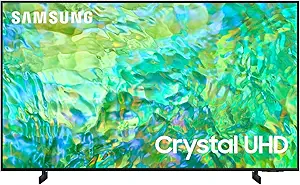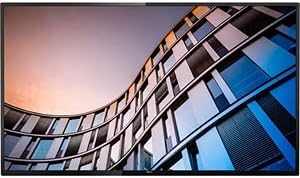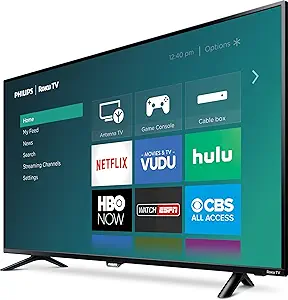Samsung and Philips are two super-popular manufacturers of electronic equipment. Of course, comparing Samsung vs Philips LED TV, it’s fair to say that Samsung is more popular than Philips. However, both brands offer their innovative technologies for picture quality improvement almost every year and it’s hard to say which one of them does better. Both manufacturers are able to offer budget, mid-priced, and premium series of smart TVs.
Picture Quality
Samsung television sets have garnered acclaim for their exceptional visual clarity, primarily attributed to their employment of Quantum Dot innovation. This cutting-edge technology empowers Samsung displays to exhibit a broader spectrum of colors and shades, culminating in imagery that is more vivid and realistic. Moreover, Samsung's QLED TVs integrate Direct Full Array backlighting to regulate light emission across distinct sections of the screen, enriching contrast and deepening black levels. Nevertheless, certain users have raised concerns regarding viewing angles with specific models, impacting the overall visual experience. Conversely, Philips TVs leverage Pixel Precise Ultra HD and P5 Perfect Picture Engine technologies to elevate their visual performance. The former ensures precise sharpness, fluid motion, profound contrast, and rich colors, while the latter further refines image quality by mitigating noise and refining sharpness. Additionally, Philips incorporates Ambilight technology, extending the TV screen's colors onto the surrounding walls, delivering an immersive viewing ambiance. However, compared to Samsung, Philips TVs may have a narrower color gamut, and the overall visual fidelity might be marginally lower. Despite this disparity, Philips television sets still deliver commendable visual performance, positioning them as a compelling alternative to Samsung.
Design
In assessing the aesthetic attributes of Samsung and Philips televisions, each brand showcases distinct merits and drawbacks. Samsung TVs are celebrated for their contemporary and streamlined designs, characterized by slim bezels that optimize screen real estate, fostering a heightened sense of immersion during viewing sessions. Notably, the latest iterations such as the Samsung QLED TV boast an Ambient Mode feature, seamlessly blending the screen into the surrounding decor when inactive. Nonetheless, there have been user reports regarding the less-than-ideal sturdiness of stands accompanying certain Samsung models.
Conversely, Philips televisions present a diverse array of designs tailored to various preferences and requirements. Embracing a more traditional approach, Philips TVs often feature wider bezels and conventional stands, evoking a timeless aesthetic. Yet, what truly sets Philips apart is its innovative Ambilight technology, which extends the vibrant hues from the screen onto the adjacent walls, elevating the immersive viewing experience. While this distinctive feature enhances the visual allure of the television in a living space, some users find it overly distracting, preferring the minimalist design ethos of Samsung TVs.
Sound
Samsung televisions have gained acclaim for their audio prowess, often bolstered by the integration of Dolby Digital Plus technology. This advanced feature facilitates a captivating cinematic audio journey right from the confines of your living space. Furthermore, select Samsung models showcase Object Tracking Sound (OTS) technology, which furnishes a three-dimensional auditory landscape synchronized with on-screen movements. Nevertheless, the auditory performance may fluctuate across various models, prompting some users to invest in supplementary soundbars or speakers to attain optimal sound levels and quality.
In contrast, Philips televisions come equipped with Incredible Surround technology, transcending conventional stereo sound to deliver an enveloping auditory experience. Additionally, certain Philips models incorporate Dolby Atmos, introducing an overhead dimension to the audio output for an immersive three-dimensional sound encounter. Nonetheless, akin to Samsung, auditory consistency may vary among different Philips models, with occasional observations of lacking bass depth in select variants. While Philips televisions generally deliver satisfactory sound encounters, achieving a truly cinematic audio immersion may necessitate the addition of external sound apparatus.
Quality and Performance
In the realm of television manufacturing, Samsung and Philips stand as prominent contenders, each presenting an array of models distinguished by their unique attributes and performance metrics. Samsung sets itself apart with its renowned displays, incorporating cutting-edge Quantum Dot technology in its latest iterations to ensure unparalleled color precision and HDR10+ support for heightened dynamic range. Furthermore, Samsung TVs boast commendable refresh rates and response times, rendering them well-suited for immersive experiences, such as sports broadcasts and gaming sessions. Nonetheless, certain users have voiced concerns regarding the long-term durability of Samsung TVs, potentially impacting their overall longevity.
On the other hand, Philips garners recognition for its innovative Ambilight technology, which extends the television screen's hues onto the surrounding wall, engendering a more immersive viewing ambiance. While Philips TVs generally offer seamless and responsive user interfaces, they may not match Samsung's prowess in terms of refresh rates and response times. Moreover, Philips models often present a more budget-friendly option compared to Samsung counterparts, albeit sometimes at the sacrifice of build quality and advanced functionalities. Despite these variances, both Samsung and Philips deliver competitive quality and performance within the television market landscape, with Samsung excelling in display technology while Philips distinguishes itself with the unique Ambilight feature.
Smart TV and Connectivity
Samsung and Philips emerge as frontrunners within the television sector, presenting a diverse selection of Smart TVs equipped with advanced connectivity functionalities. Samsung's Smart TVs distinguish themselves through seamless integration with Samsung's proprietary ecosystem, featuring the Bixby voice assistant, SmartThings for IoT connectivity, and compatibility with a plethora of streaming services. Additionally, Samsung TVs seamlessly support Apple AirPlay 2, facilitating effortless streaming from Apple devices. Nonetheless, they lack support for older legacy video inputs such as VGA or component video.
Conversely, Philips television sets operate on the Android TV platform, granting users access to an extensive array of applications via the Google Play Store, alongside the convenience of Google Assistant for voice commands and built-in Chromecast for effortless content sharing from mobile devices. Furthermore, Philips TVs boast support for HDMI-CEC and HDMI ARC, streamlining device control via a singular remote. However, the absence of a native Apple TV app may pose a limitation for Apple enthusiasts opting for Philips TVs.
In comparison to other contenders in the market, both Samsung and Philips offer a compelling suite of connectivity options. Samsung holds appeal for users deeply entrenched within the Samsung or Apple ecosystems, while Philips caters to individuals prioritizing the versatility and expansive app catalog offered by Android TV.
Brand Reputation
Samsung and Philips stand as illustrious contenders within the television domain, each holding distinct positions in the market landscape. Hailing from South Korea, Samsung, a multinational conglomerate, commands recognition for its cutting-edge technological innovations, premium displays, and pioneering features. Notably, their latest QLED technology sets a benchmark with its unparalleled color accuracy and image clarity, garnering widespread acclaim among consumers. Samsung's commitment to exceptional customer service and the production of durable goods further elevates their brand esteem, albeit their premium televisions may pose affordability challenges for certain budgets.
Contrastingly, Philips, a Dutch multinational conglomerate, is esteemed for its steadfast performance and affordability. Philips televisions are synonymous with reliability, offering a consistent viewing experience at a reasonable price point. Noteworthy is Philips' signature Ambilight technology, which casts a vibrant spectrum of colors onto the surrounding walls, enriching the viewing ambiance. Moreover, Philips boasts a comprehensive lineup of smart TVs featuring integrated Google Assistant and Chromecast functionalities. Nonetheless, Philips may lag behind Samsung concerning picture quality and the incorporation of advanced features. Criticism aimed at Philips' customer service in specific regions may also impact their brand perception in comparison to Samsung.
The decision between these two renowned brands hinges on individual preferences and financial considerations, as each brand presents its unique strengths and weaknesses.
Brightness
When evaluating the luminosity characteristics of Samsung and Philips televisions, multiple considerations come into play. Samsung, especially with its QLED line, earns recognition for its elevated brightness levels. Thanks to QLED technology, Samsung TVs boast peak brightness reaching up to 2000 nits, surpassing the majority of competitors in the market. This heightened luminance proves advantageous in well-lit environments, effectively mitigating glare and reflections. Nonetheless, it's important to acknowledge that excessively high brightness levels may occasionally compromise color fidelity.
Conversely, Philips televisions, particularly those utilizing OLED technology, prioritize color precision and contrast over sheer luminosity. Typically, Philips OLED TVs maintain peak brightness levels hovering around 700-800 nits. Although this falls short of Samsung's QLED models, it remains sufficient for most viewing scenarios. Furthermore, Philips sets itself apart with its Ambilight technology, which projects on-screen hues onto the surrounding walls, augmenting perceived brightness and immersive qualities. However, in exceptionally bright settings, Philips TVs may not deliver optimal performance compared to Samsung counterparts, owing to their lower luminance capabilities.
Smart Features
While Samsung and Philips televisions both boast an array of smart capabilities, notable distinctions exist in their underlying technology and operational functionalities. Samsung, a prominent player in the industry, adopts Tizen OS as the foundation for its smart TV platforms, delivering a seamless and intuitive user interface. Tizen OS facilitates broad app support, encompassing popular streaming services such as Netflix, Amazon Prime, and Hulu. Furthermore, Samsung integrates voice control capabilities via Bixby and Alexa, enabling hands-free operation. Moreover, Samsung's smart TVs incorporate the SmartThings app, empowering users to seamlessly connect and manage smart home devices directly from their television sets.
In contrast, Philips televisions harness Android TV to power their smart features, providing access to an extensive array of applications accessible through the Google Play Store. This expansive library encompasses streaming services, gaming options, and productivity tools. Additionally, Philips TVs support Google Assistant for voice commands, while built-in Chromecast facilitates effortless content sharing from external devices. However, in comparison to Samsung, Philips may offer limited support for smart home devices. Furthermore, some users may perceive Android TV's interface as more intricate than Samsung's Tizen OS.
Both brands present robust smart functionalities, yet the preference between Samsung and Philips may hinge on individual user inclinations towards specific platforms and operational attributes.
Remote Control
The remote controls accompanying Samsung and Philips televisions boast distinctive features and technologies, setting them apart in the realm of user experience. Samsung's remote, christened the One Remote, epitomizes minimalism and sophistication, tailored for effortless navigation. Equipped with cutting-edge functionalities like voice control, users can effortlessly switch channels, adjust volume levels, and even manage connected devices with simple voice commands. However, some users have encountered challenges with its minimalist design, which reduces the number of physical buttons, especially for those accustomed to conventional remote controls.
Contrastingly, Philips' remote controls strike a balance between traditional and contemporary designs. Retaining a higher count of physical buttons for direct access to essential functions, Philips appeals to users favoring a more intuitive interface. Moreover, Philips integrates smart features into their remotes, including a built-in keyboard, streamlining text input and enhancing usability for browsing and content searching endeavors. Nevertheless, Philips' remotes lack advanced functionalities like voice control compared to Samsung's offerings. In summary, while Samsung's remote caters to the preferences of modern, tech-savvy users, Philips adopts a more inclusive approach, catering to the needs of both traditional and contemporary users.
Philips PUS8807 vs Samsung Q60 Smart TV
Conclusion
The Philips vs Samsung 4K TV comparison demonstrates that both brands use the latest technologies to make their models better. TVs from Samsung are better when it comes to picture quality, OS, number of ports, and features. Philips TVs have better sound, durability, and more beneficial price.




















